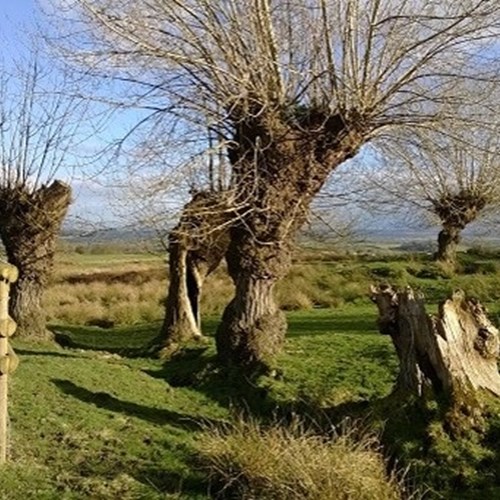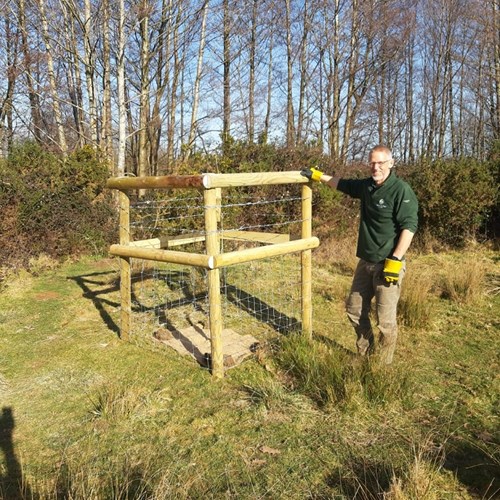Background of Black Poplars
The rare native black poplar tree Populus nigra betulifolia can be found around the commons of Malvern.
Some years ago, a national survey of these black poplars was done and only around 5,000 were found in the UK. To halt the loss of more black poplars many more trees have been planted in various places around the country. The Trust have been replanting native black poplars since the late 1990s.

Warden Rich stands beside a newly planted black poplar in a cattle-proof guard.
All of our old black poplars have been historically managed as pollards. This is traditional management practice where the tree branches are trimmed off every few years above the height cattle at which can graze and then left to regrow. The trees were once pollarded to harvest material for a range of wooden products including thatching spars, bean poles and clothes pegs, as well as fodder for livestock. These trees in the landscape are part of our cultural heritage


A recently pollarded black poplar in winter. A recently pollarded black poplar in summer with regrowth.
Over time the pollarded trees develop into an inverted funnel shape and often have lots of nooks and crannies which provides homes for invertebrates, bats and nesting sites for birds. The pollarding process is thought to extend the life of these trees and many specimens are more than 100 years old.
On parts of the commons some trees haven’t been re-pollarded for some years, and have grown out. Look at many trees around the hedgerows and woodlands in the UK and you will see the trunk divides at just above the height that cattle can browse and these trees would have likely once been pollards. We have a wonderful example of this outside Hollybush Church.
New life
Trees don’t live forever and now and again one will collapse, or just come to the end of its life. We see that as an opportunity to plant some more.

A collapsed black poplar tree.
Now we have some tall, well-established new trees a decision has to be made about how they will be managed. Some trees will be left to into standard trees, particularly female trees recently introduced into the local population. Other trees will be pollarded to produce this classic funnel shaped pollard. This will continue the traditional management which is part of the area's natural heritage and provide a diversity of habitats for wildlife.

Young black poplar trees in cattle-proof guards.
When researching how to establish a pollard, it was evident that pollarding new black poplar trees is rare and any information on this type of tree management was difficult to find. We took some advice from those pollarding other species and decided to take the plunge. In January this year a suitable tree, planted around 10 years ago by our warden Rich, was identified. Rich started by pruning lower branches to raise the crown above the browsing height of cattle.

Warden Rich pruning lower branches within reaching distance of cattle.
The main stem was then cut off at a place above where the cattle could browse.

The newly pollarded black poplar (left) and standard black poplar (right) in January 2024.
As this was the first new pollard undertaken by Trust staff on a young black poplar, there was some uncertainty as to how successful the management would be. The tree was regularly monitored and we were delighted when new shoots appeared in the spring. as to whether this would start this process off, but we checked the tree for regrowth as we were passing and breathed a sigh or relief as the new shoots started to appear in spring.

New growth on pollarded black poplar in early spring 2024.
Eight months after the tree was pollarded, there is lots of healthy regrowth and is looking like a classic miniature pollard.

New growth on pollarded black poplar.



